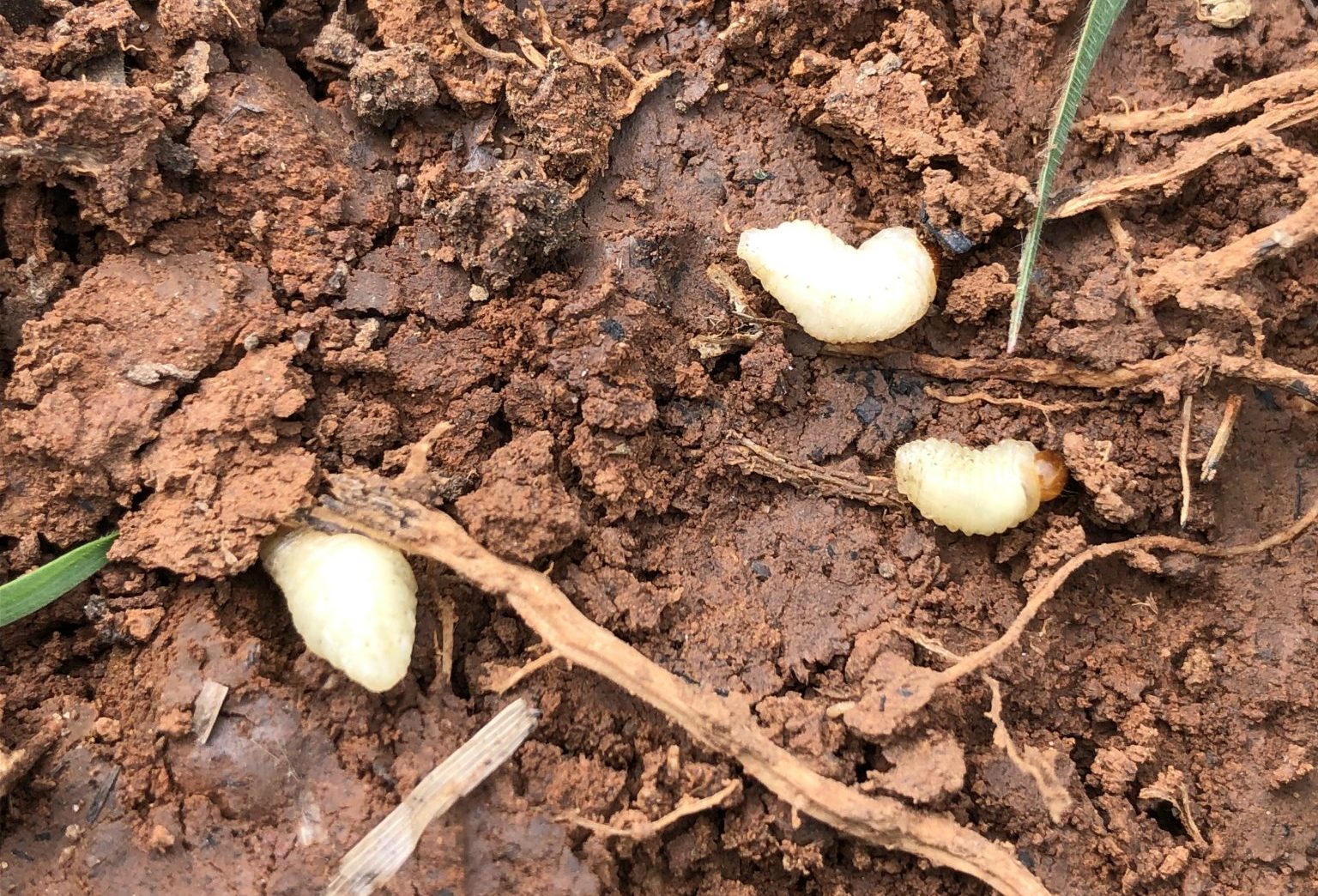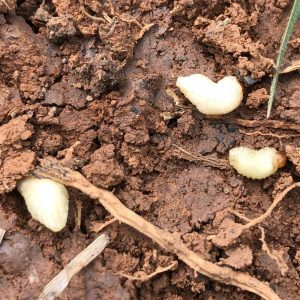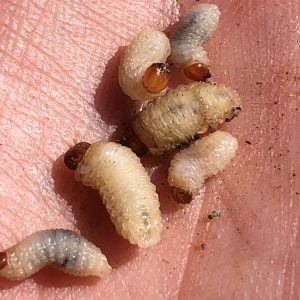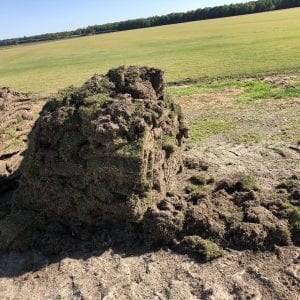Lawn & Garden

Billbugs are a group of long-snouted beetles in the weevil family (Curculionidae) that can cause extensive turf damage. The hunting billbug is the dominant species in the southeastern U.S., including Alabama. It is important to understand the biology and seasonal dynamics of billbugs to better control them in turf.
Billbugs are a group of long-snouted beetles in the weevil family (Curculionidae) that can cause extensive turf damage. There are ten species of billbugs in the U.S. that are destructive to turf, and their range extends as far south as Mexico, throughout the entire continental U.S. and Hawaii, and into southern Canada. The two species that are the most widely recognized and most serious pests in turf are the bluegrass billbug (Sphenophorus parvulus Gyllenhal) and the hunting billbug (Sphenophorus venatus vestitus Chittenden). The hunting billbug is the dominant species in the southeastern U.S., including Alabama, although detailed information about this destructive pest is minimal. Nonetheless, it is important to understand the biology and seasonal dynamics of billbugs to better control them.
Grasses at Risk
The bluegrass billbug primarily infests cool-season grasses, especially Kentucky bluegrass. It can also be found on some warm-season grasses and grassy weeds. The hunting billbug causes the most severe injury in zoysiagrass and is sometimes called the zoysiagrass billbug, but it will also damage bermudagrass, St. Augustinegrass, and centipedegrass. Sod producers are the hardest hit by billbug infestation because their feeding destroys the stems that hold sod together when cut and make it impossible to harvest. In addition to turf, the hunting billbug will feed and reproduce on nutsedge, crabgrass, wheat, corn, and other plants.
Biology
Adult billbugs can be recognized by their long snouts and black or gray bodies. They are identified to species using markings on the tops of their heads and forewings. Billbug larvae are legless grubs that can be distinguished from common white grubs by their lack of legs (figure 1). They have cream-colored bodies with a sclerotized (hardened) head capsule that is tan (figure 2).
While they do possess wings, billbug adults cannot fly more than a few inches off the ground. They are often found moving across sidewalks or driveways. The adults feed on grasses using their chewing mouthparts, but adult damage is primarily superficial and not usually of concern. The larva is the most destructive life stage.
Females lay eggs into feeding holes right above the crown of the plant. Newly hatched larvae feed within the grass stem. The stems become hollowed out and can sometimes be easily pulled out by hand. As the larvae grow and get too big for the stem, they migrate into the soil and feed on the roots, causing further damage. Large larvae feed in the soil until pupation.
Billbugs typically have a 1-year life cycle and will overwinter as adults in protected areas such as leaf litter, worm holes, or hedgerows. In the spring, adults begin feeding and laying eggs. They crawl on sidewalks and driveways toward grassy areas. Hunting billbugs lay eggs from May through September. In southern regions, all life stages are present throughout most of the year, complicating management strategies.
By late summer, all of the larval and most destructive feeding is done and the billbugs are looking for a place to spend the winter. In Alabama, the warm season is long enough that the summer adults can lay eggs and create a partial second generation.
- Figure 1. Billbugs in soil as legless white grubs found at the root zone.
- Figure 2. Billbugs from an infested sod farm in Alabama. Note the hardened head capsule and lack of legs.
- Figure 3. Sod heavily damaged from billbugs.
Signs of Damage
In the spring and summer, billbug damage is often misidentified as grass that has failed to green up. It is also often confused with disease or drought, but these areas will not respond to watering. This is because the larvae have damaged the roots so severely that the grass cannot obtain water and nutrients from the soil. Damaged patches will start out as irregularly shaped or rounded areas of brown or yellowing grass and sometimes begin near sidewalks or walkways. Since the adults cannot fly, they crawl along the pavement and sometimes begin infesting where the grass meets walkways.
In areas of heavy feeding, saw-dust like material may build up around the area. This is frass, or insect excrement, from the larvae. Over time, multiple patches in one area can coalesce into one big patch that results in total destruction. Most warm-season grasses affected by billbugs cannot be seeded and must be resprigged. Billbug infestations on sod farms in the southeast often cause the grass to fall apart when producers attempt to harvest it (figure 3). This can happen even when there is no visible aboveground damage.
Scouting for Billbugs
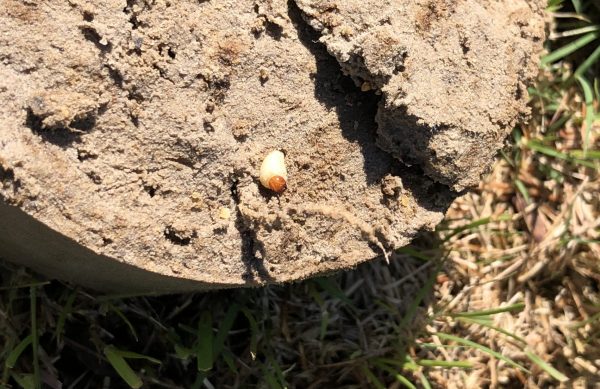
Figure 4. Soil core with billbug.
There are three main ways to check turf for billbugs: look for adults above the surface, look for larvae in the soil, or check for the presence of larvae using the tug test, which consists of pulling on yellow or brown stems to see if larvae are attached.
As adults come out of overwintering in spring, they crawl along sidewalks and other pavement headed toward turf areas. Since the hunting billbug is nocturnal, shining a flashlight on turf at night is another way to detect their presence.
One method of capturing crawling adults is using pitfall traps. Linear pitfall traps can be used to cover more area, but a regular plastic cup will work fine as well. Use a cup cutter to dig a hole in the ground, place one cup so the top rim is flush with the ground surface, and place a second cup in the first one. Fill the top cup about one-third full with soapy water to capture adult billbugs, which will crawl on the grass as they forage and will fall into the pitfall trap. The soapy water acts as a killing agent. Check the trap at least once a week. If there are between 5 and 10 adults per week, expect extensive damage.
Taking soil cores is one way to find larvae in the ground (figure 4). Look specifically at the crown and in the root zone for the presence of the legless larvae. Finally, use the tug test and pull on stems that are yellow or brown. If they break off easily and are full of the sawdust-like frass, it is likely billbug larvae are present.
Managing Billbugs
Managing billbugs is complicated for several reasons. In Alabama and other southern turf regions, all life stages (egg, larva, pupa, and adult) may be present simultaneously. Some larvae will be protected in the stem, while others will be in the soil. Adults may be foraging on the grass, while others are crawling on paved areas moving toward the turf. In addition, billbug- infested materials are easily transported to noninfested areas on shoes, equipment, or vehicles.
Left uncontrolled, a population of billbugs can kill a large area within a matter of weeks. For this reason, producers often preventatively apply insecticides that have long residuals. These systemic treatments must be applied early, before egg hatch, to affect the earliest larvae. While the majority of larvae are suppressed using this tactic, it is not foolproof. Hunting billbugs may travel too deep in the soil for the reach of some soil insecticides. Further, the widespread prophylactic application of insecticides is troublesome in the era of insecticide resistance. With limited modes of action to control insect pests in turf, chemicals must be used as part of an integrated management strategy that includes rotating chemistries and cultural and biological control.
One potential for biological control is using entomopathogenic nematodes to control the larval stage. Three species of nematodes, Steinernema carpocapsae, Steinernema feltiae, and Heterorhabditis bacteriophora, have all been used successfully. These nematodes are reared commercially and can be purchased and applied for pest suppression in a variety of settings from turfgrass to agricultural systems.
Entomopathogenic nematodes must be used carefully to ensure maximum efficiency. Store them in a refrigerator and use them as soon as possible. Once mixed, apply the nematodes immediately to the turf. Nematodes and their efficacy are significantly affected by UV radiation and moisture; therefore, do not apply them in the heat of the day but rather first in the morning or at dusk. Irrigate immediately after applying to soak the nematodes into the turf.
As with white grubs, preventative or curative applications can be made to control adult billbugs as they emerge from overwintering in the spring. Contact insecticides such as pyrethroids, carbamates, or organophosphates target adults before they can lay eggs. It is difficult, however, to time preventive applications due to the lack of information about billbug biology and the short residual of contact insecticides. It is best to monitor for adults using pitfall traps and time the application accordingly.
For preventive control of larvae, use systemic insecticides such as neonicotinoids or diamides, which target young larvae inside the stems following successful egg hatch and also provide some control of adults. Apply in the spring before extensive damage is noticeable.
Curative applications are used after turf damage is noticeable and target larvae in the crowns or soil to minimize an already damaging infestation. Soil insecticides labeled for turf, such as carbamates, organophosphates, or neonicontinoids, can be used for this approach. It is important to note that curative applications will not magically repair damaged sod. The grass must have time and the right conditions to regrow in order to be harvested again. Insecticide applications made late in the growing season often do not result in harvestable sod until the next spring.
For a complete list of products for use in Alabama turf, refer to Extension publication IPM-1313, “Commercial Turf and Lawn IPM Guide.”
 Katelyn Kesheimer, Extension Specialist, Assistant Professor, Entomology and Plant Pathology, Auburn University
Katelyn Kesheimer, Extension Specialist, Assistant Professor, Entomology and Plant Pathology, Auburn University
Reviewed August 2023, Billbugs in Turf, ANR-2770

